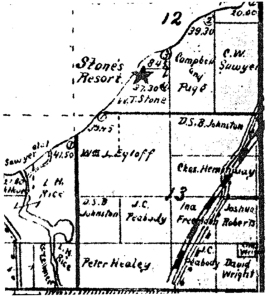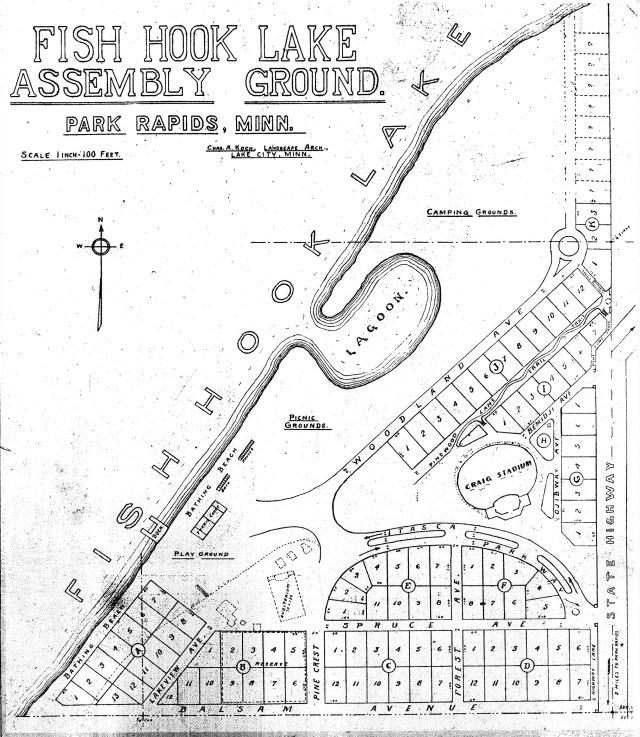William J. fenced his land. It certainly served a purpose in South Dakota where he and his brother Max owned thousands of acres, some of which were good only for grazing. Will’s reasons for fencing his quarter section in Todd Township were not as clear. We know at least one neighbor took advantage of the fence when Hattie allowed him to graze cattle in 1930’s, but there are no other instances of anything else being fenced in by the Will’s barbed wire fence. Maybe he was fencing out potential vandals and timber thieves. There were break-ins to Comfort Lodge in the early years, and occasional family discussions about stumps whose tops could not be accounted for.
The second generation replaced the original wood with iron posts in the late 1940’s, but the third generation seemed to lose interest. Most of the barbed wire can still be found, lying on the ground, except along the north line.
‘Why do they make good neighbors? Isn’t it Where there are cows? But here there are no cows. Before I built a wall I’d ask to know What I was walling in or walling out, And to whom I was like to give offense. Something there is that doesn’t love a wall, That wants it down.’ Robert Frost 1914.Frost argument that walls do not make good neighbors was not articulated clearly in our family until one of our neighbors, Sue Hibberd, Chair of the Northern Pines Camp at the time, and I were talking about the fence. After not finding any clear purpose for it, she said, “Why don’t we take it down”. And we did, rolled it up and hauled it to Roger Peterka’s scrape metal place south of Rapids Spirits on 170th St.
So now our north boundary line is imaginary. Only the road that runs parallel to it serves to mark the edge of the Egloff land.
That road, aka Balsam Avenue, has a long history. Balsam Avenue was dedicated for public use in 1922, then subsequently vacated in 1980-1990’s. Who, why, how and when public use was vacated is very murky but apparently real.
It’s current name of Forget-Me-Not Drive was adopted on Liz Smith’s suggestion for the now private road owned by the Methodists when the county adopted a uniform 911 road naming system in the 1990’s.
Balsam Avenue was first built in 1920’s when the Community Club, a small group of town boosters, bought the land from Dr. W. T. Stone. Stone built a hospital in 1902 on the west bank of the Fish Hook River (where the River Park Villas are now located). At the outset Dr. Stone might have used the Assembly Ground’s land for convalescing patients to get fresh air and exercise. Without a passable roads to the property they were transported to the site by boat. By 1908, however, the place had become the Stone Resort for “private parties and families who wished a lake outing from any time from a day to a season.” Cottages were built and a large clubhouse was “located on a high bluff overlooking the lake…with an approach by a stairway of easy slope.”

Todd Twp 1914 Plat. with Stone’s Resort (45.75 ac) and Wm J. Egloff (149.45 ac). Note road from Park Rapids parallels railroad track.
As the only hospital in town and one of only two resorts on the lake, both should have thrived. That they did not resulted from a combination of unfortunate factors the most important of which was the death Martha Stone in 1917 at the age of 60. She was the business manager while Dr. Stone attended to patients and served in the Minnesota state legislature for two terms (1911-1914). Within a year of Martha’s death the hospital and the resort closed. The banks allowed the hospital to remain in the family and was reopened as the Rainbow Hotel by Dr. Stone’s two sons. The resort was put up for sale.
The Commercial Club bought it in 1920 and began a search for someone to operate it in a way that would enrich the community and repay them for their investment. They eventually secured the cooperation of the Methodists to develop the property as a summer assembly grounds like those at Pacific Grove, California and Oaks Bluff, Martha’s Vineyard, Massachusetts, except the Northern Pines was to be interdenominational.
The original plat for the Assembly Grounds, showed “92 choice lots, 60 x 100 feet” and several streets, the longest of which was Balsam Avenue, which ran east and west between their property and ours.
Lots were sold to raise money to repay the Commercial Club members, but few cottages were built. The cottages built were all but one on lots at the water’s edge in the southwest corner of the property. One of those lots was purchased by The Reverend Frank A. Cone; his son Earle Richard Cone designed and built a cottage for them. That cottage (now the Kelly’s) still stands, recognizable by its large fireplace of boulders carried from the lake, some of them by a teenage Martha Egloff.
Balsam Avenue served primarily as access for the cottages and to a designated county boat landing through the 1950’s. Not much changed until the late 1940’s when the Rural Electrification Authority planted poles with electrical transmission wires along the south side the road. in the process twenty-two Norways were removed from the Egloff’s land. The loss of the trees was significant, but more than offset by the excitment and joy of having electricity in Comfort Lodge, Max’s cabin and the new Cone Cabin.
In 1949 the lake shore was divided into six lots, platted as EGLOFF SHORES and divided between Will and Hattie’s three children. Martha got Lots 1 and 5, Max Lots 2 and 6, and Bill Lots 3 and 4, which included Comfort Lodge.
In 1955 Max who was ailing and needing cash decided to sell Lot 6, the lot on the northeast, next to the Methodists. A realtor introduced him to an elderly man who said he wanted it for a small cabin to use as a base for fishing. A classic shell game. The realtor immediately resold the house to Ruth and Joe McCartney, a manufacturer from Kansas, who preceded to build a large summer lodge, an upscale version of Comfort Lodge with bedrooms opening directly onto a large living room with a central fireplace and a spectacular view of the lake from the top of a low bluff. After Joe died in 1963, Ruth, their daughter Sandy Ehlers and family of Spicer MN, and Ruth’s second husband Abner Houck continued to enjoy the cottage until Ruth sold it to Liz and Phil Smith in 1996.
Ruth was aware that the proceedings to vacate public use of Balsam Avenue could jeopardize her access to her cottage. Her response was to erect two steel posts where Balsam Avenue meets the county highway; once a year her caretaker would put a steel cable between the posts during the winter. Ruth and her lawyer thot this would establish her right to continued use and maybe eventual ownership of the road by the law of adverse possession. The Methodists tolerated the inconvenience and everyone continued to use Balsam Avenue as if it were still a public road.


Thanks for the acknowledgement of my naming “Forget Me Not Drive”. When Gertrude Zentz came north from Florida the first summer after the road was officially named, she said”Whoever named the road must not have written it down first because it sure takes a long time to write it!”